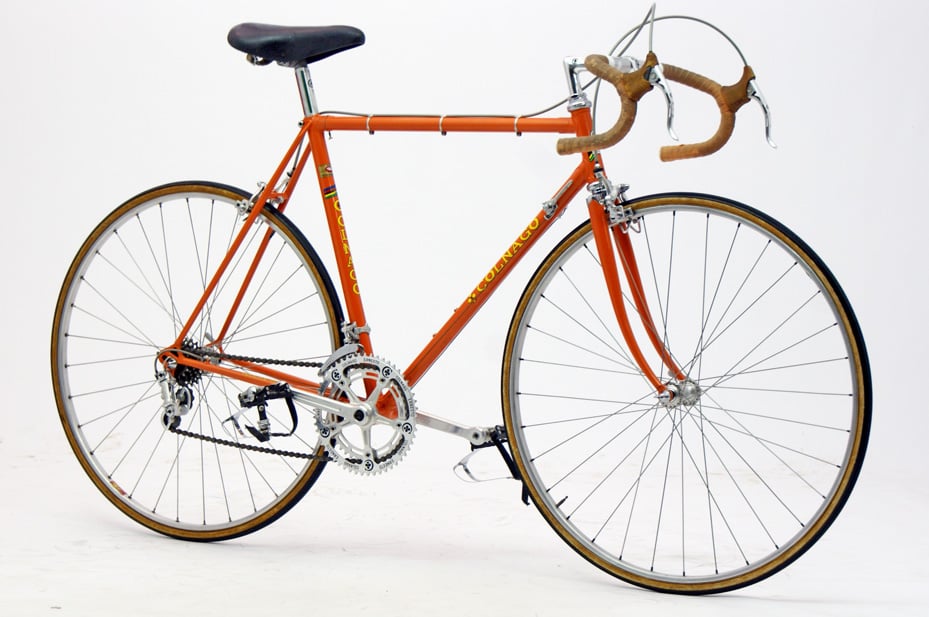
Image courtesy of www.speedbicycles.ch
The Colnago Super bicycle was the first production model Colnago released back in 1968. It was manufactured using Columbus SL tubing, however larger frame sizes used thicker Columbus SP tubing. You can see in the chart below that a 57cm Colnago Super frame and fork was barely any lighter than a larger 58cm Colnago Super frame and fork.
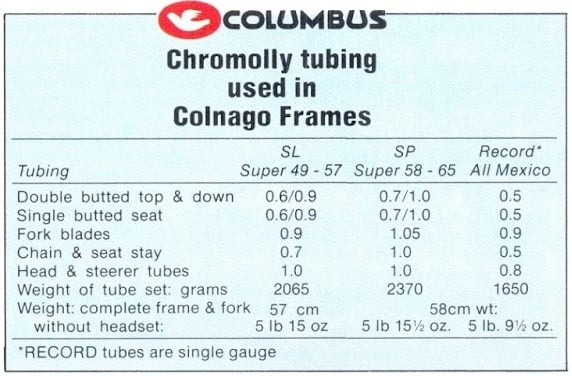
Colnago designed this frame for high performance using a different geometry to other manufacturers of the period. The Colnago Super was also stiffer and lighter. It was extremely popular and remained in production for some 30+ years. For majority of those years, the Colnago Super was built using plain round tubes for the top tube, down tube and seat tube. It also featured crimped chain stays. If you have a Colnago vintage steel frame with 3 round tubes, there is a high likelihood the frame is a Colnago Super.
During all those years of production, the frame received regular updates to it’s design and styling. If you compare a 1970’s Colnago Super frame with a 1980’s model, there are many features that will be different. To add to the complexity, variants of the Colnago Super were released like the Colnago Superissimo and Colnago Super Sprint making it a bit more complicated to determine an exact model.
Using this Guide.
This guide has been created to help you work out the vintage of a Colnago Super bicycle and is a pictorial representation of the information sourced from the following references.
www.classicvintagecycles.org
www.velo-retro.com
Remember, these references outline when a specific feature or detail was introduced, but the feature may have remained in use for a number of years. So expect this information to help you to narrow down the vintage of your frame to a period (ie. early 70’s, mid 70’s, late 70’s etc.) rather than an exact year.
Where possible, I have included links to the complete set of photos for each bike shown in this guide. You will find that sometimes the supplier of these images has dated the model differently to this guide, which does not mean that it is incorrect. I have simply included pictures that match the features described by the aforementioned references. Whilst this guide utilizes the best sources of information I can find online, I am not able to confirm the accuracy.
Before you begin.
The first step is to make sure that the 3 main tubes of your frame ie. top tube, down tube & seat tube are all plain round tubes. If any of these tubes are profiled, oval or crimped, then you should start with how to identify a Colnago vintage bike.
Features of an early Colnago Super.
If your frame requires clamp mounted components as shown in the following images, then it would be an early model. Images courtesy of www.speedbicycles.ch.
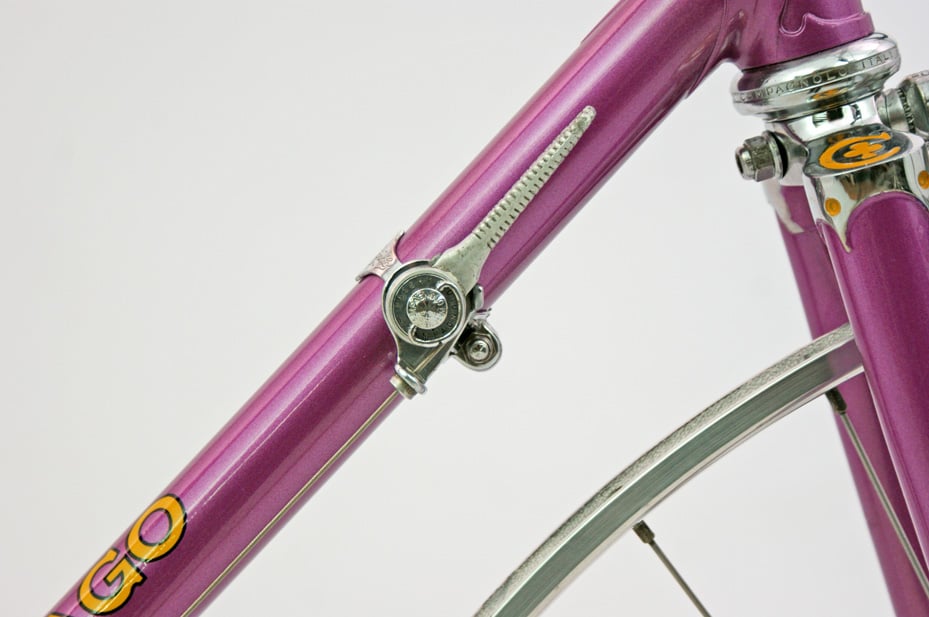
Clamp on shift levers. 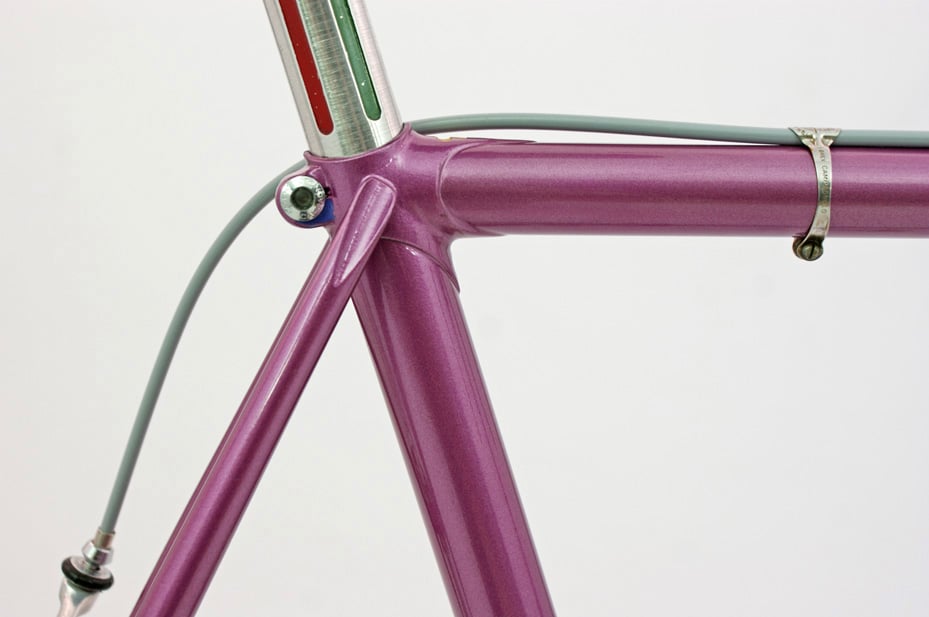
Rear brake top tube cable clamp. 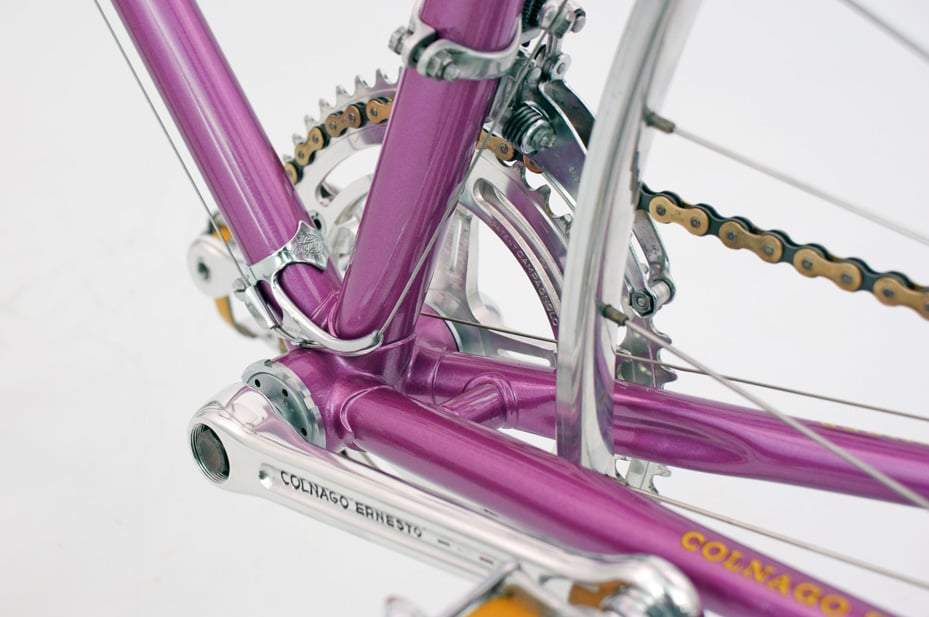
Clamp on down tube shift cable guides. Crimping to chain stays.
Tube shaped chain stay bridge.
Colnago Super (circa 1968).
The following photos highlight features typical to a frame of this era. Learn more about this type of frame in how to identify a Colnago Super Roma. Images courtesy of Art Bikes.
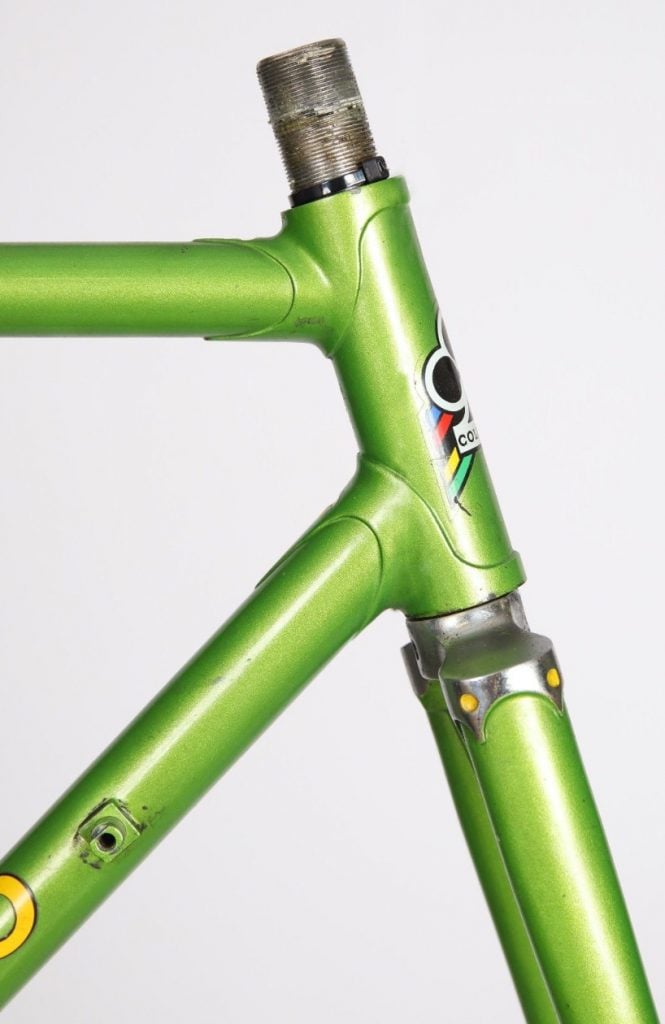
Fork features 2 x circles on each side of the fork crown.
Down tube shifter braze-on mounts were an early option.
Club symbols in both head tube lugs. 
Club symbol in top of seat tube lug.
Top tube brake cable braze-on guides and early option.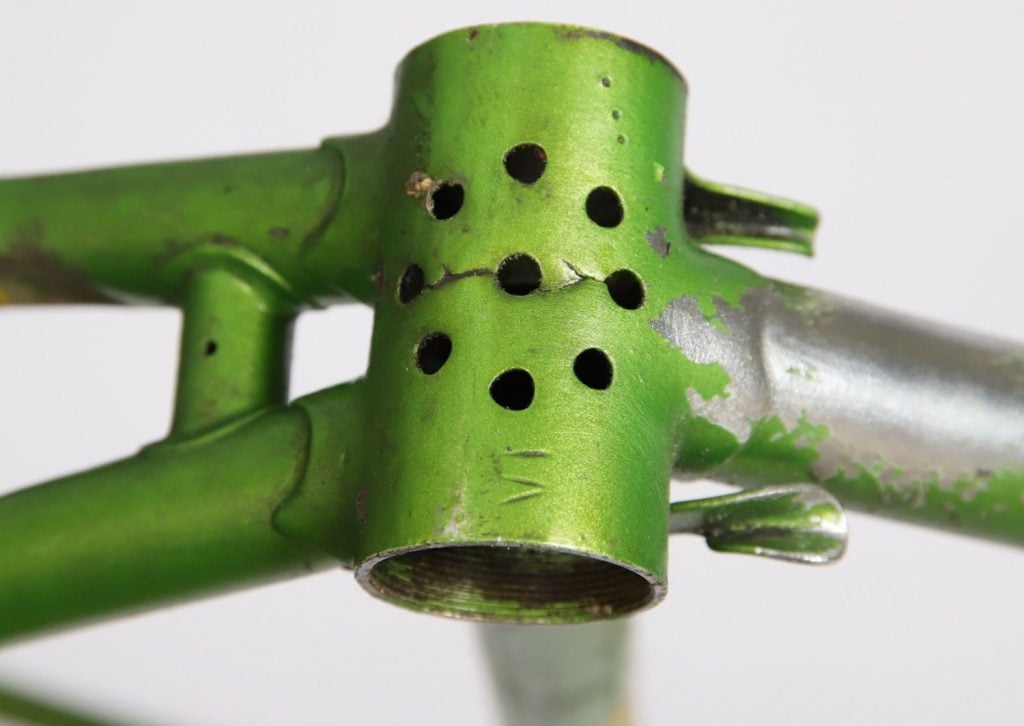
Bottom bracket shell has 9 drilled holes.
Colnago Super (circa 1971).
The following photos highlight features typical to a frame of this era.
Images courtesy of www.speedbicycles.ch.
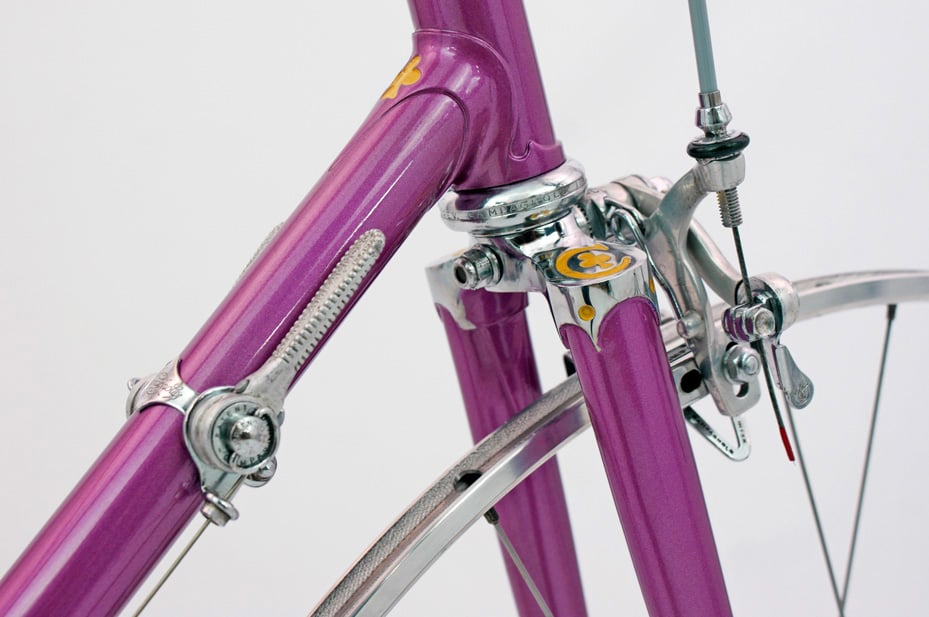
Fork features a “C” with a club inside it on top of the crown
and 2 x circles on each side of the fork crown.
Club symbol in both head tube lugs, but the lower club is bigger.
Club symbol on top of seat tube lug.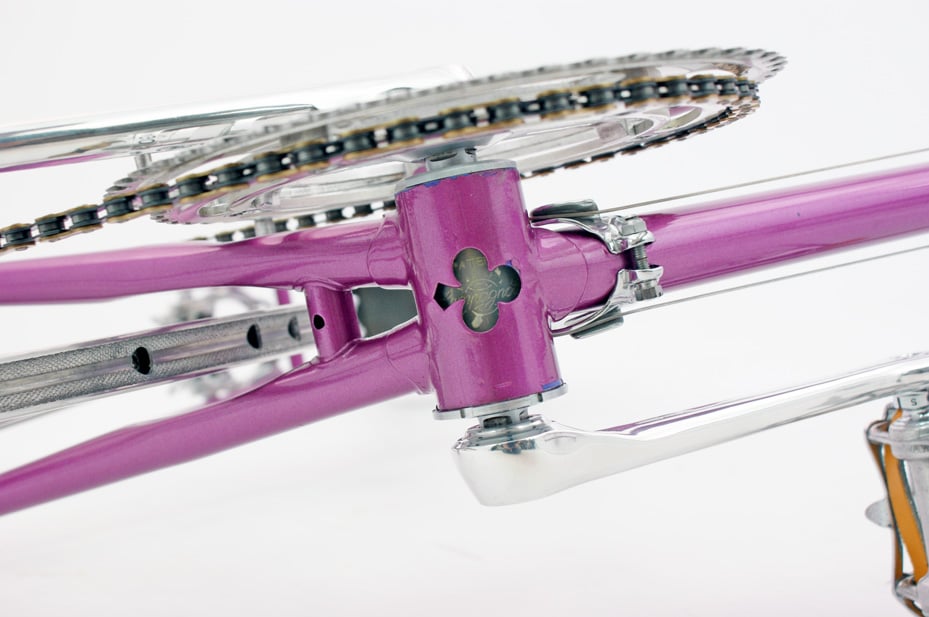
Bottom bracket club cut-out.
Colnago Super (circa 1972).
The following photo features braze mounts for a single down tube mounted biddon cage (circa 1972). Image courtesy of www.speedbicycles.ch.

Braze-on bottle cage mounts on down tube.
Colnago Super (circa 1973).
The following photos highlight features typical to a frame of this era.
Images courtesy of www.speedbicycles.ch.

Fork features a club symbol on top of crown and small club symbols on
inside fork tangs. Head tube features a club symbol in the lower lug only.
Colnago Super (circa 1974).
The following photos highlight features typical to a frame of this era.
Images courtesy of www.speedbicycles.ch.
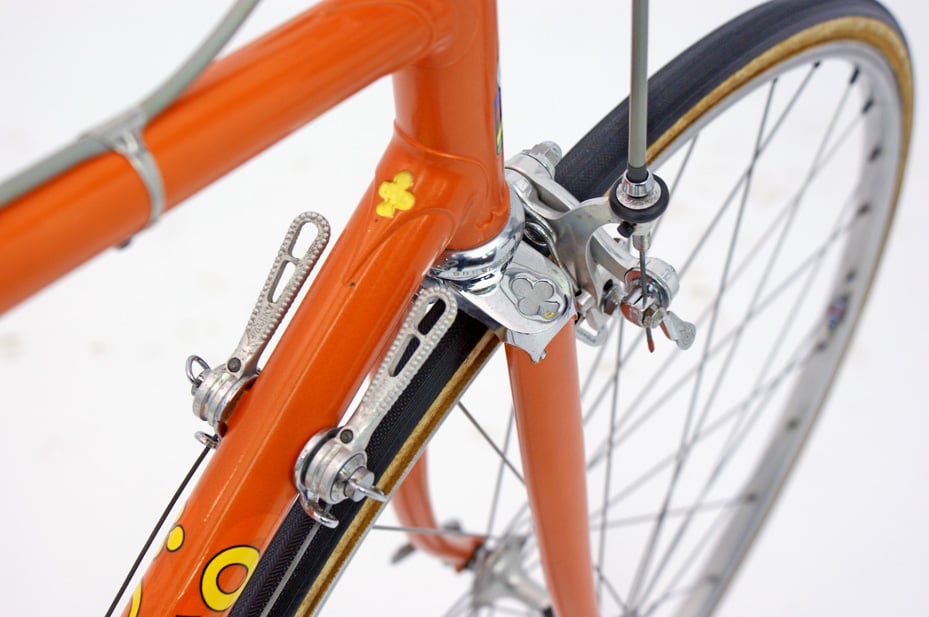
Shifter braze-ons standard on the down tube (option prior).
Colnago Super (circa 1976).
The following photos highlight features typical to a frame of this era.
Images courtesy of www.speedbicycles.ch.
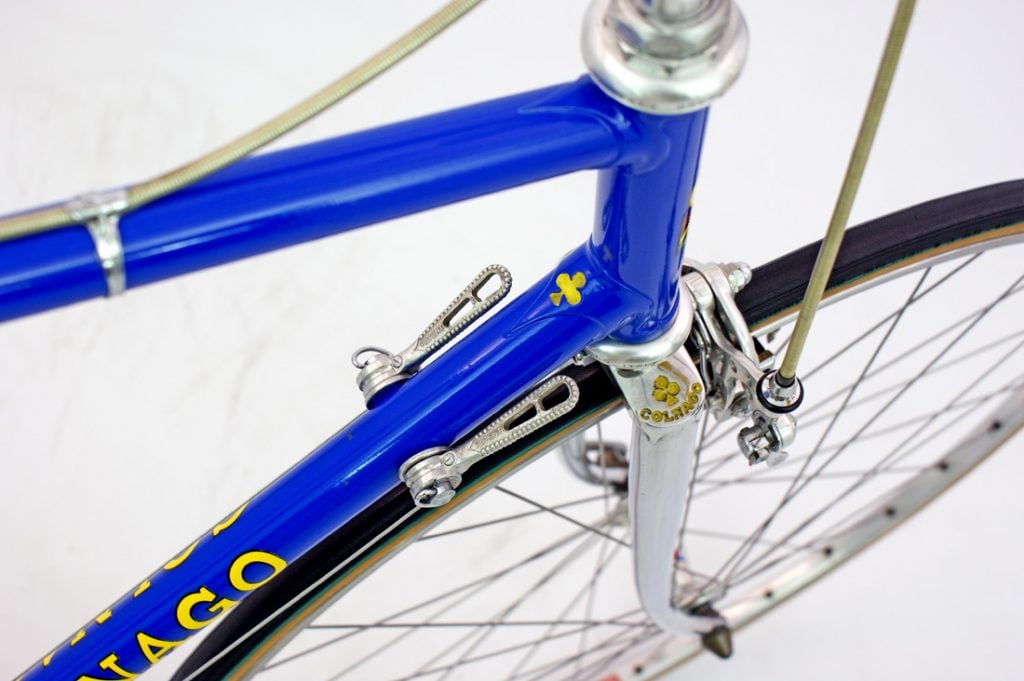
Fork features both a club symbol with ‘Colnago’ lettering below it.
Colnago Super (circa 1978).
The following photos highlight features typical to a frame of this era.
Images courtesy of www.classicsteelbikes.com.
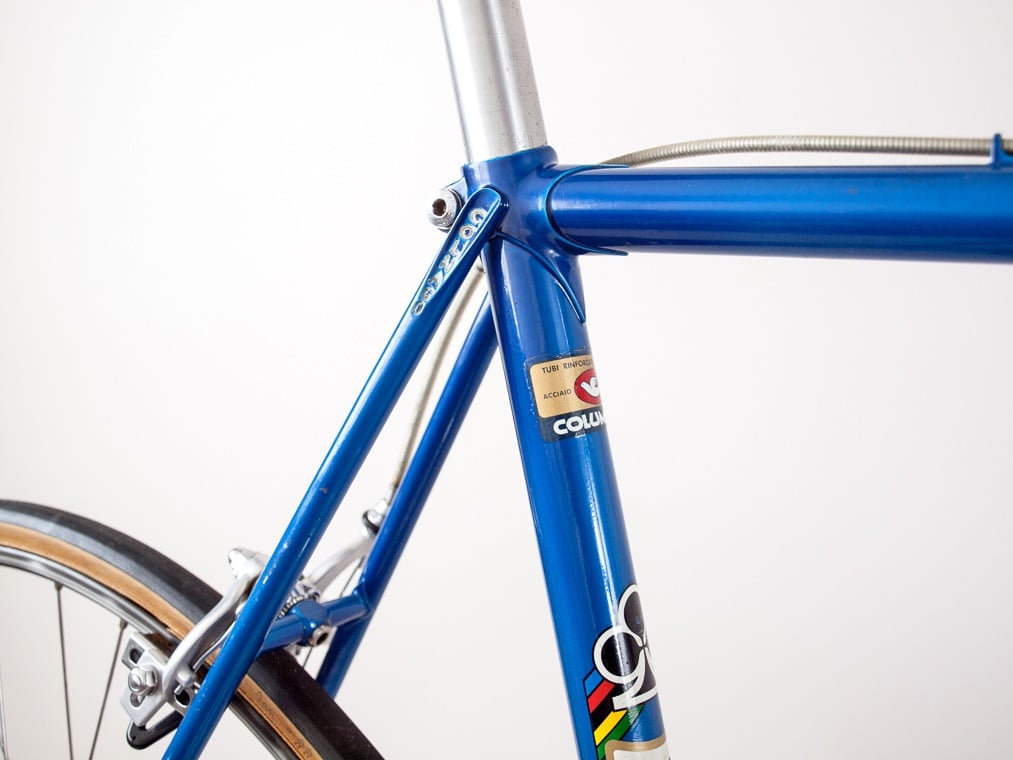
Rear brake calliper mounting nut recessed into the frame.
In earlier models the mounting nut was exposed as shown in previous images.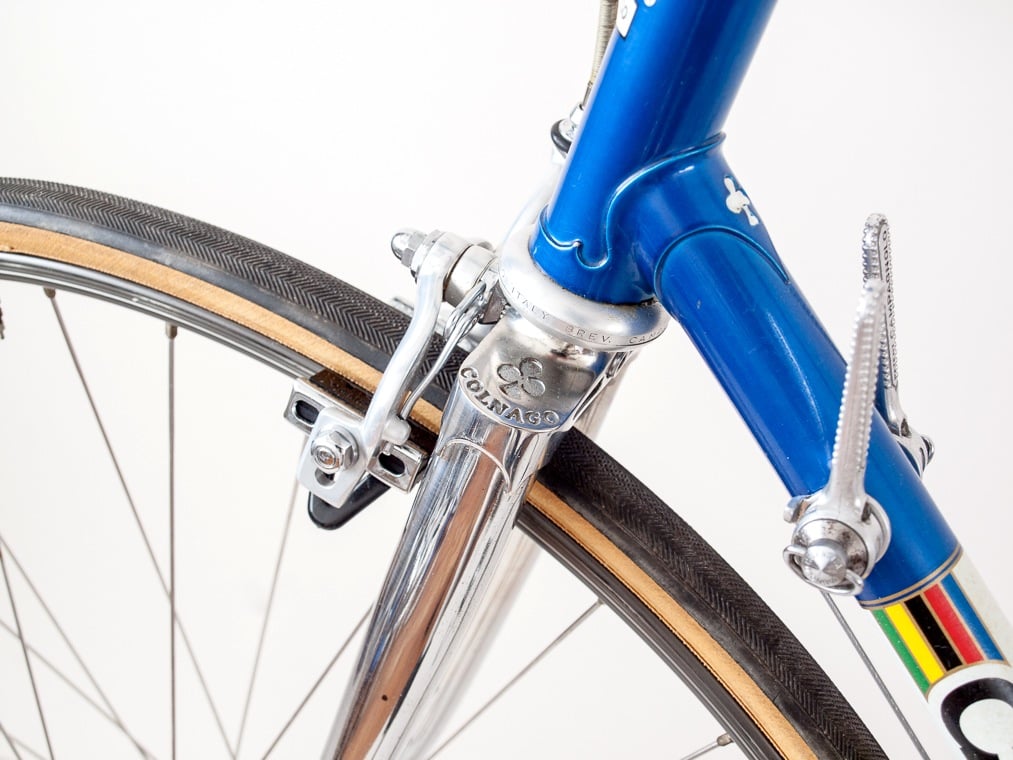
Front brake calliper mounting nut recessed into the frame.
In earlier models the mounting nut was exposed as shown in previous images.
Colnago Super (circa 1981).
The following photos highlight features typical to a frame of this era.
Images courtesy of premium-cycling.com and www.vintagevelo.co.uk.

Chain stay bridge is changed from a simple tube shape to a spool shape.
Chain stay crimping altered to a longer crimp on the inside of each stay.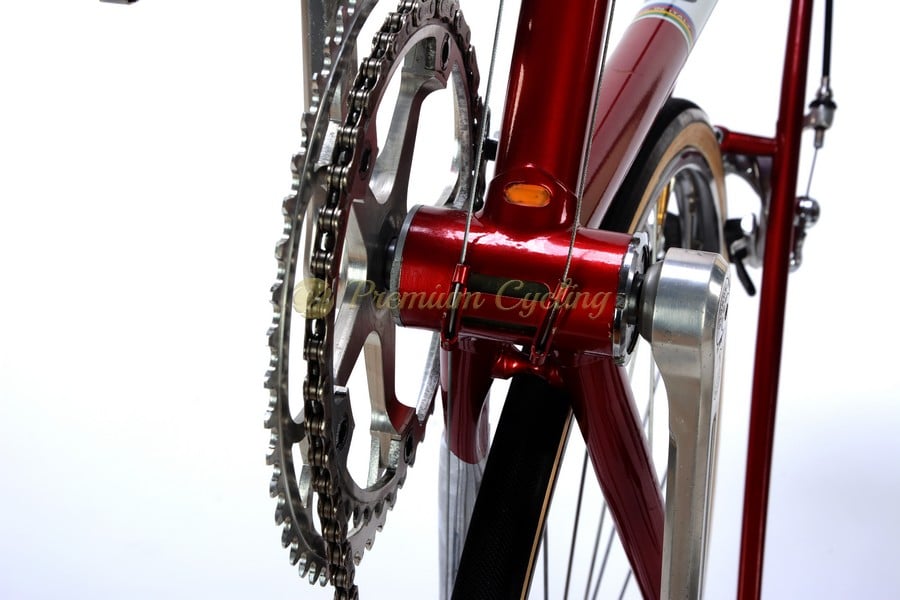
Shift cables routed under the bottom bracket.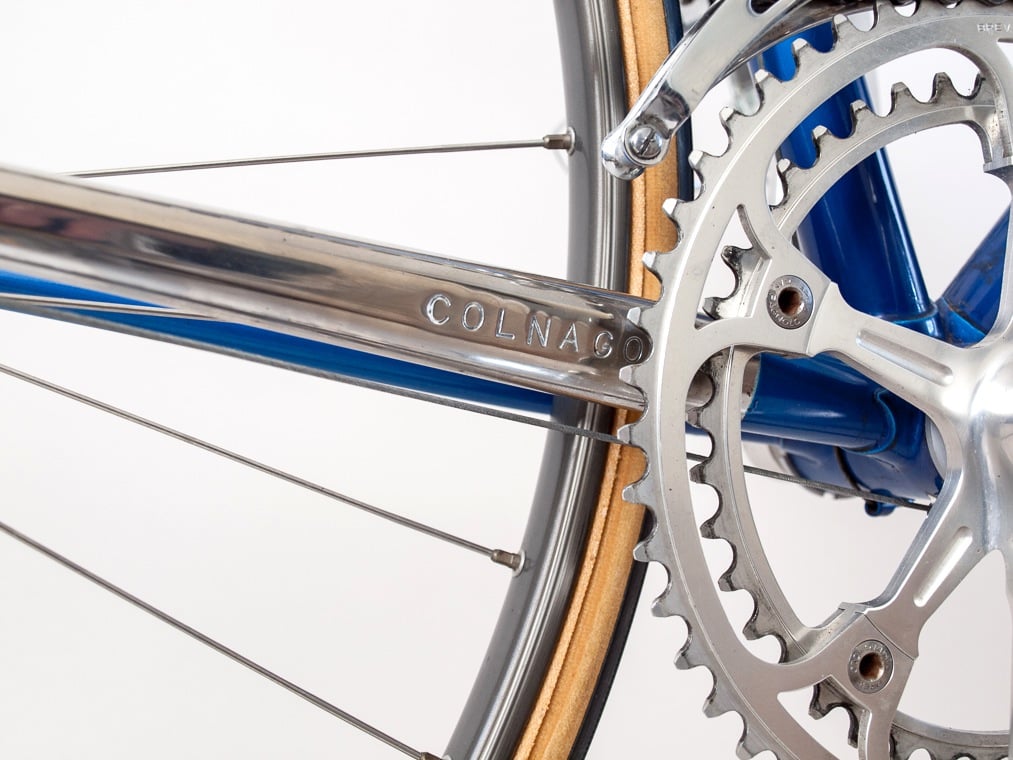
Chain stays feature ‘Colnago lettering.
The following excerpt below is from a USA Colnago dealer catalogue (1981).

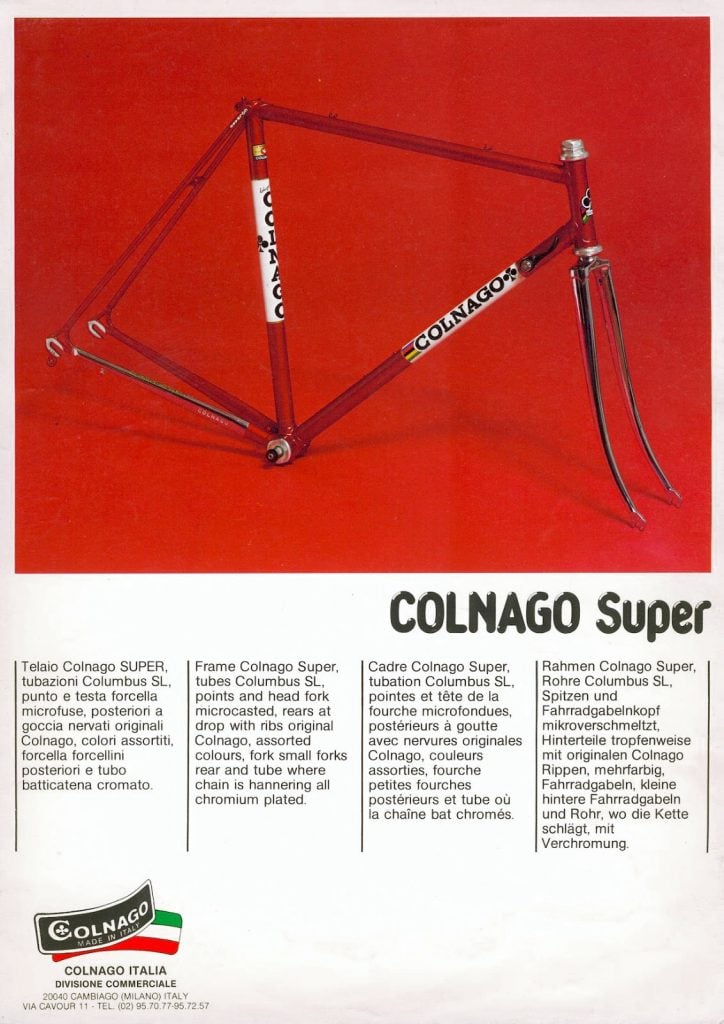
Colnago Super beyond the mid 1980’s
The Colnago Super (built using Columbus SL tubes) was last advertised in the 1992 Colnago catalog as a Super Piu. In the 1994 Colnago catalogue, the Super Piu was advertised with Tange tubing, and in the 1996 catalogue, the Superissimo was advertised with Brain tubing.
Colnago Super Più.
Any model with a Più suffix implies that the rear brake cable is routed internally in the top tube of the frame, instead of on top of the top tube. Whilst an official Colnago Super Più model was advertised in the 1992 catalog. Internal rear brake cable routing was an option that could be included on earlier frames by customer request.
Colnago Super Profil.
Learn how to identify a Colnago Super Profil bike.
Colnago Superissimo
This model was very similar to the Colnago Super, you can learn more in how to identify a Colnago Superissimo.
Other Colnago Catalogue Variants.
- ‘Victory’ which was a Colnago Super frame supplied with a Campagnolo Victory group set.
Colnago Literature.
The following websites have a large selection scanned Colnago literature including reviews, catalogues and brochures.
Article References.
I hope you found this article interesting. I have listed the following website pages as general references.
www.classicvintagecycles.org
www.velo-retro.com
Disclaimer!
Please remember that this information is only to be used as a guide.
I consider myself an enthusiast, not an expert. The information I have presented in this article is based on my many hours of online research.
In addition, there will always be frames that don’t quite match the characteristics of a particular model as they could have been a custom build, prototype etc. Note: forks can also be swapped between different frames.
About Me.
I have been riding and working on my own bikes for many years now. I wanted to share my experiences, knowledge and research with others. My aim is to inspire people to get involved in all aspects of this amazing sport. Cheers.
Comments.
I welcome reader feedback in the comments section. Should you wish to suggest an amendment, please include a note advising the source of your information so that myself and other readers can ascertain the accuracy of your information. Note: Trolling or argumentative comments will be removed as they are counter-productive.
Hi, what a brilliant site, very useful. Can I ask if I can send a photo showing a Super frame from around 1977? The seller suggests it is, however, I am not so sure?
Kind regards
John
Hi John,
Thanks for posting a comment and your kind words. In regards to your query, unfortunately I don’t consider myself an expert on Colnago frame identification. I simply created this website to be a compilation of all the information I found online. This page contains everything I have learnt about the different versions of the Colnago Super. If the frame you wish to purchase doesn’t match the typical features of a frame depicted here, then you are right to be cautious.
Thanks so much for the info here – a real delight to find an enthusiast with so much useful information.
Hi, thanks for leaving a comment, it is appreciated.
Great info! Do you know anything about Colnago Superissimo’s made with three brake cable guides on the toptube instead of two?
Hi Joshua, looking through some 80s & 90s Colnago catalogues, there were definitely frames that featured 3 cable guides on the top tube for routing the rear brake cable, however they were not shown specifically on the Superissimo. Typically variations do occur, possibly the customer or frame builder decided to add 3 guides or maybe larger size frames got an extra guide. My Master and Nuovo Mexico are 56cm top tube frames and they only have 2 guides. How large is the top tube of your frame (center of head tube to center of seat tube)?
Interesting about the 3 cable guides as I recently bought a restored Nuovo Mexico with 3 guides – and its in a small size!
I’ve been advised by people more knowledgeable than me that an extra cable guide was a factory option back in the day.
Hi Gary, thanks for posting a comment about 3 cable guides in your small size frame. Definitely helpful to know.
Hi. Found your article very interesting, as despite my ownership of 14 Colnagos (including 3 of my original race bikes from the 1980s) I am puzzled as to the the identity of a frame I acquired a few months ago and am trying to build up.
It was advertised as a Super that had been resprayed but the owner sadly passed away before he could pick up the frame. I wanted to recreate one of my original Saronni red Supers (which I stupidly sold in the 80s!) so I took the plunge and negotiated a decent price.
Aside from the painted forks (over chrome dropouts) it ticks all the boxes as a 1980s Super…until this week when I tried to build it!
The bottom bracket shell is 68 mm Italian thread. Now it may have been faced down from 70 but it did seem a bit odd. The real issue is that the seat tube appears to be 27mm – as a Super Record 27.2mm seatpost became a real struggle to get in! I did get it there but it was literally starting to shave alloy off the post. I took it out with a view to polishing the post down a fraction.
I thought then maybe it was a later model in Thron tubing, but is that also 27.2?
There is a frame number but Colnago can’t access the records.
Happy to send photos but for now your thoughts will be of interest.
Regards
Ted
Hi Ted. What a fleet of Colnago bikes you have!
If the definition of happiness = number of bikes owned + 1, you would be a very happy man, except the new +1 is apparently causing a bit of grief.
Unfortunately the old Colnago literature I have has no details regarding the seat tube diameters or BB specs for their different frames over the years.
I have 2 early-mid 1980s Colnago bikes and they both frames have 27.2mm diameter seat tubes and 70mm Italian bottom bracket shells, so that was nice and easy.
Feel free to post a link to pictures in the comments section, I’m happy to take a look and other readers may be able to chime in.
Hi and thanks for your recent reply.
The bike is finished and in the end I just rubbed down the seatpin to get it to fit. I’m still none the wiser on the year of manufacture though!
I am featuring the bike on my Twitter feed later today (Sunday 14th) as I have featured one every week for the past 12 weeks. There will be plenty of photos for you to have a look at:
@feckingpsycho
You may well find all of the other posts I’ve made about them but more than happy to send photo’s to you via email so you can see the full collection (assuming you’re interested of course!).
Original ’86 Arabesque; ’88 Master; Krono; Dream; C50; C60; Ottanta 5; C64 and Rui Costa’s 2017 C60 team bike.
All above bought new (and the first three all raced).
A recently acquired Carbitubo; recently built C40 and a Super I had new in ’86 that I have recently rebuilt.
Good night from the UK!
Hi Ted,
I just had a look at your (up to) 13 weeks Colnago bikes on Twitter.
Talk about a pristine collection of amazing bikes, no cheap ‘n’ cheerful bikes in that collection.
It’s a bit like having the Colnago museum in the comfort your own home!
I just sent you an email with an idea for a new page.
Regarding your seat post issue; I have had this problem with seat posts on other frames. It has thus far been the result of the deformation of the lug/tube. I have been able to repair via a variety of methods and use the proper post without any issues. Is it possible that you have “SP” tubing vice “SL” due to a large frame size? I have a 57cm Super frame and it still utilizes a 27.2mm post size.
Hello Sir,
I want to buy this Colnago frame and fork but I don’t know how to identify it… What frame is?
Many thanks!
https://www.olx.ro/oferta/cadru-cursiera-colnago-IDdzFkO.html#a55b8b3484
Hi Valaerica,
Not many detailed photos to go by, but it looks like all round tubes so I expect it is in the Super family. Some features indicate a mid to late 1980’s era. I suspect it has been repainted with possibly some new decals added. The decal on the seat tube says SLX so if that were original, it would likely be a Superissimo, but hard to say for sure. There is quite a mix of components on this bike. If you buy it, I would recommend you take it to a bike shop to remove the bar tape, rotate the handle bars and move the levers to the standard locations, then apply a new bar tape in white or black. https://cycling-obsession.com/how-to-identify-a-colnago-superissimo/
Hey. I’ve been looking at a Colnago super for sale. I think it’s from the 80’s. Could you help me identify about what year it is? It’s on Craigslist and I have the link for it.
https://boise.craigslist.org/bik/d/boise-colnago-full-campagnolo/7125128765.html
Thanks!
Hi Thornton, looks like the owner has already changed their mind. The ad is gone.
Good evening all,
Recently bought a lot of bikes and in there was a Colnago. I’m battling to find the exact model as it the decals show Colnago Sport but the frame has characteristics of the Super. Any assistance would be greatly appreciated.
Hi Bradley. Aftermarket decals can easily be purchased and applied to any frame, so it is possible the frame is a Super. Have you read this page on How to identify a Colnago Sport
Ciao,
I just acquired, what I think may be a 1981 Super. Possibly someone may be able to pinpoint the vintage. It has the club cutout under the bottom bracket, but no script. It has the long arching cable guides, on each side of the club cutout. Both top and bottom stays are chrome-plated.
The fork crowns have the club and Colnago cutouts designs. It has the lower rear stay tapered spreader tube. The top tub has the 2 cable housing stops brazed on. The chainring center has 5 spokes. Both rear stays are chromed, but ends before the seat post.
Thanks!
Giovanni
Hi Giovanni, based on your description, it sounds like a frame from around that era. If you post a link to some photos, we might be able to give you a more accurate year model.
Hi Rouleur,
I have a few early Colnagos and few later models. If you would be interested in photos of the earlier models (or any model) I would be happy to contribute. I primarily ride and rebuild Italian and European race bikes from the 50s to 80s. Colnago: “Super” (year unknown, circa ’75/’76, Camp. date codes from ’74; original decals match no example I have seen), “Nuovo Mexico” ’86 (2nd generation frame style), “Saronni Criterium” (year unknown circa early 80s, “aero” top and down tubes are oval, “Saronni” I have seen 3 other examples; never seen one in a catalogue), “Carbitubo” (year unknown circa late ’80s-early ’90s, never ridden display model with custom matching Camp. “Delta” brakes), “Super Piu” (year unknown circa early ’90s), “Asso” ’01. If you are looking for photos of these or other Italian and European marques let me know. Some are frames, and some are complete bikes. Happy to help others.
Take care,
Jesper
Hi Jesper, that sounds like you have a very nice collection of bikes. Thanks also for your generous offer to provide images of your bikes. I restricted the Colnago models in this guide to be released before the 1990’s so some of your frames would beyond that, however I’m always happy to have a look at some pictures of any of your bikes if you want to post a link.
But, I don’t have an article on how to identify the Saronni Criterium which sounds like an interesting and rare model, so if you are able to supply a link to some images of that frame/bike I would be happy to create a new page for it and credit you for the images. Specifically photos required would be a photo of the entire frame/bike, pics of the oval top and down tubes (to show the special shape) and pics of any specific markings on the frame will be great to help people identify it. Cheers.
Hi. Great article. I’m thinking of taking on my first vintage bike build project, actually my first bike build project. Ive seen this frame forsale and think it looks like a genuine 70s original but would appreciate a second opinion if you dont mind. https://www.facebook.com/marketplace/item/308354280220253/
Hi Jason. Thanks for your kind words. You posted your comment on the Colnago Super page, but I believe the bike you are looking to buy is a refurbished mid to late 1980’s Colnago Superissimo. The frame looks to be been nicely refurbished and would make a great vintage project. To give you some tips on building a vintage bike, checkout my Colnago Nuovo Mexico bike restoration and build article.
Well done, Rouleur, on an absolutely fabulous and very important resource for all cycling enthusiasts!
I am just starting my journey into the world of Colnago and vintage rebuilds. I’ve recently been given a Super that is in need of some serious TLC. I was wondering if you were able to identify the year of this bike? Looking at your research, I’m guessing it’s around 1980. There is a slightly surprising mix of Dura Ace and Campagnolo and I also wondered if they were every sold like this or perhaps parts have been changed somewhere along the way? I’ve included some photos here – I hope you can see them. I’m very excited to be bringing this bike back to life.
Hi Joe, thanks for your kind words. Great to hear this info has been of help to you. Fantastic to hear you are going to bring a classic Colnago back to life. You get a lot of satisfaction restoring a bike, it creates a special connection you just don’t get buying a new bike from the local shop. I think the parts may have been mixed and matched overtime on your bike. Regardless it is very easy to buy Campagnolo parts on eBay if you want to standardise the build. You know the old adage; Italian components for an Italian frame. I have written up a heap of articles on parts from that era in my Vintage Campagnolo Super Record Review. If you are going to re-spray & re-chrome the frame it is worth taking a lot at my experience with this process for my Colnago Nuovo Mexico Bicycle Restoration. Also I was unable to look at your photos, it is a protected folder.
Thanks again for the encouragement. I think I have ‘unprotected’ the folder, so hopefully they can be seen by everyone and add to the knowledge base.
https://drive.google.com/drive/folders/12niFMEBDu_uA74MWABs_c4mXNeTfhLBV?usp=sharing
Hi Joe,
That is going to be a challenging project. The fork looks to be quite rusted, hopefully the rust is not too deep so it can be polished out and still safe to use, otherwise the frame looks like it should restore well. The frame looks like 1970’s. If the brake bolt mounting nuts are recessed, then I would say late 1970’s. The seat post is really low, hopefully it is not rusted in and can be removed without too much drama. Right side bottom bracket cup will be the other part that could be difficult to remove. What are your plans for this restoration? Full respray & re-chrome? Retain all original parts or replace some? The modern saddle is probably the only thing that really stands out. Love the pantographed large chain ring.
Hello again, I’ve added a few more pictures to the file. You can see that the forks are coming up quite nicely. One image shows the forks after I’ve rubbed one side down using Diet Coke and aluminium foil – this worked surprisingly well! They still need more work but I am hoping to avoid having to have them re-chromed. The frame will be re-sprayed. I’m thinking of a classic blue with the same yellow detailing that is evident now and the same yellow decals. The brake bolt mounting nuts don’t appear to be recessed, so I guess that means it’s a bit earlier than late 70’s? Luckily the seat stem came out easily and revealed some nice yellow fluting details too. I was given the original Colnago saddle. The Campagnolo brakes also have the yellow detailing, so I suppose these were finessed by Colnago. I like the idea of Italian parts for Italian bikes, so I think I’ll keep my eyes open for Campagnolo parts to replace the 3 Dura Ace ones (both mechs and brake levers). You were correct about the bottom bracket. I assume the lock ring is counter-clockwise to loosen on both sides? This is going to take a while!
https://drive.google.com/drive/folders/12niFMEBDu_uA74MWABs_c4mXNeTfhLBV?usp=sharing
Hi Joe. You’ve done a great job on the fork leg, it looks great. Lots of nice details on the components too. Getting the right tool for that drive side bottom bracket cup will be critical. I believe all Colnago frames have Italian threading which is anti-clockwise to loosen. I suspect it may not be a Campagnolo BB looking at the notches on the drive side. It’s going to come up great. Definately search for replacement decals before removing the old ones if you want to match the originals. Cyclomondo do high quality decals and can custom make ones they dont have in stock.
Therefore, I keep dudes about its authenticity.If it is a real Colnago bike.
The frame, anyway, seems to be a high end piece of the seveenties, since the old decal in seat tube, before the respray, it is Columbus SL (anyway it could be added), and the rear dropouts are Campagnolo (it can be read on the dropout, in one the pics : ” brev. Camp.”).
I have got another Super and the dropouts are Columbus.
The bycicle seems to be from the late seveenties, because of the brake cable guides.
I would appreciate if you could help me with it.
Thanks.
https://photos.app.goo.gl/XpkX2JduXRQGnHPeA
Good Morning,
I’d liked to be sure about the authenticty about this bike that seems to be s Colnago Super (because of the identations in the chain stay that it can de apreciatted in the picture before restauration) but the bottom bracket is lacked of the club Colnago mark.Instead of it there are two parallel rectangular cutted holes.
Observing the pictures, shown in the link below, the frame seems to belongs to a top classic racing bike (Columbus SL decal on seat tube in picture before the repainting or the Campagnolo dropouts) but I keep serious dudes about if this bike is a real colnago bike (despite of club marks in the fork crown and in the head tube lug).
Waiting for your contribution, thank you in advance.
https://photos.app.goo.gl/XpkX2JduXRQGnHPeA
The photos are a little unclear, but the lower head tube lug and forks match a genuine Colnago frame. Some of their frames have cut-out slots under the bottom bracket rather than a club cut-out as shown in this image on the page.
Thank you very much for your answer.
Then, your conclussion, after seeing the pictures, is that is a real Colnago frame, despite of the lack of club mark in bottom bracket?
I also saw in Internet a Colnago Super with a non club (clover) mark laser cutted in the bottom bracket anf it was, like this bike, a big size frame (62 ct), the same size, in fact.I don’t know of the size is related with it.
It is also a colnago Super (despite of the claiming of being a Colnago Mexico), isn’t it?
I don’t know if this kind of bottom brackets with the two slots belongs to some determined models or to a specific period of time.
Thanks again.
I would guess the dual cut-outs under the BB were related to a time period but not sure. I expect their purpose was to provide ventilation and drainage at the lowest point of the steel frame. The original Colnago Mexico doesnt have indents in the chain stays, the Super of that period does. Hard to tell from the photos, but you can see examples of the indents on this page.
Thank you very much for your help and your explanations
It’s very probably hat it’s a Colnago Super despite of being a Mexico model according to the seller claiming, because of chain stay indentations that it can be seen in the old picture, before respraying althought it is not easy to detect it.
Anyway, the most important issue is that is a true Colnago.
If it is a Colnago Super instead of a Colnago Mexico it is not so important as if it was a fake Colnago.
You’re welcome, hopefully it brings you lots of satisfaction riding it. Looks like quite few Campagnolo Super Record components fitted to the bike as well which is nice. I think Colnago have a much bigger problem with counterfeit modern carbon frames (coming out of China) than copies of their original steel frames. The Colnago Super was produced in large numbers and sold over many years. There are plenty of original frames out there.
Thank you very much again, Rouleur.I really appreciatte your help and your experience.
I was a little worried since I am buying this bike I showed off and I saw some differences with plenty of Colnago Super, as well as another Super I have already got (this one totally equipped with Campagnolo Super Record and,besides, a Colnago headset) and I distinguised that differences with my previous Colnago Super as I mentioned in my previous messages (lack of club cutt out in bottom bracket shell).
Another differences I saw is that the chain stays indentations are deeper In the “new frame” (first photo in the album attached in link below) than my old one (second photo in the same album).
But as you said, it may be a consecuence of the existence of so many Super bikes along these more than thirty years this model was produced and there must be different versions.
Anyway, it is undeniable that it is a top frame (with also Campanolo dropouts) and the weight of the bike, 9,5 kg, according with seller statement, is surprinsingly low for beig a big frame (62 cm (ct); 60,5 cm (cc) (this is more my size rather than the other one a 59 cm (cc) frame), and with a heavy saddle (a nice Brooks Colt).
Regarding to the components, yes, indeed, there aren’t too much Campagnolo Super Record components (just the crankset, front derailleur, a Nuovo Record rear derailleur, a C Record seatpost, if I am right, and the wheel quick releases).
I will complete it gradually.I will also try, later on, to chrome the fork crowns, as originally.
Regards.
https://photos.app.goo.gl/RGC4jhNXjR5aPvp67
Hi Miama, you can only judge by what you see in the photo’s and some of the visible features match what you would expect to see on a Colnago Super frame of that vintage, however, I am no expert – just an enthusiast. If you have any concerns about it’s authenticity, better to wait and buy a bike that you are certain is genuine. Obviously finding the right frame size, components, condition and asking price will be factors in your decision as well. But if you still decide to buy it, definitely chrome the fork crown and best of luck updating the components over time. At least you already have one classic Colnago in your collection of bikes.
Thank you again for your answer, Rouleur,
Some corrections about my last message.
The bike also has got Campagnolo Nuovo/Super Record bridge brakes (in fact, I’ ve already got some other Super Record components, like rear derailleur, one SR hub and shift levers from another bike whose I will replace for it original C Record components from this anothee bike) and the weight seems to be 9,8 kg.I missed the exact weight when writting.
I will continue with the purchase.
It’s very probably is a genuine Colnago Super.The photo you posted at Colnago Mexico section when is explained the different between these two models, shows a photo of a Super stays with deeper identations that my “old one”, althought not so deep as this new one”.
Possibly, there must be different versions with some little variations along the years of production.
And as you say, matching all variables of model, size (very difficult in my case, searching a size not less than 60 cm (cc)).
The bike frame , is, certainly, a top classic item with its weights, weight, dropouts, and type of steel tubes.
Regarding to my collection, it is growing .I have some good classic pieces, some of them that need to be replaced in some components for its original ones, like a Pinarello Gavia I’ve got equipped in Super Record and C Record, instead of only C Record or a Colnago Conic SLX Total Spiral with any original component (Camp Super Record from 1993).More difficult it will be repaint the Conic SLX in its original art decal scene and dual colors, since it was repaint in plain single color.
It is a question of time and money.
Another chapter will toey to built it up in its originals components.
Some others ones, besides my first Colnago totally equipped, like a Gazelle Champion Mondial AA with Campagnolo Nuovo Record, entirely, and other one, as well totally assembled with Nuovo Record components.Maybe, in the near future, I upgrade both bikes to Super Record.
Another history will be to built up a Alan frame (of 60 cm cc, like the another ones, also very difficult to find) I’ve also got.
As it is said, it’s a matter of time and money, and patient, because I cannot be in a hurry with it.
Regards.
Hi Miama, not sure where you have space to keep all those many bikes..haha
Certainly a collector I can see.
Yes, I became a top classic 60 cm cc racing bike collector.
It’s not all.I’ve also got a Vitus 979 bike…:).
I have got main classic steel racing bike tubes (with its complete bikes, except the Alan, just the frame by the moment), Columbus SL(two frames), Columbus SLX, SLX New, SLX Spiral Conic, Columbus FRX (a TSX specific tubes for Pinarello), Reynolds 531 (two frames), Alan and Vitus 979.
Yes, it’ s not an easy question its storage…:) I keep them in different places.Next stage will be to upgrade the bike components, chroming some parts in different bikes and painting two of them, rather to grow up the “family”… (three of them are totally asembled in its top originals components, another two in more than the half of the top original pieces, three with none one or almost zero original components and the Alan frame).
Cheers!
Thank you so much for this helpful page! I purchased what was supposed to be a 1981 Mexico but my mechanic thought it was more likely to be a Super with 1982 Campagnolo Super Record components. An Italian wrote to me after seeing the bike posted on my blog to tell me it was a Mexico as my bike did not have the crimped top tube shown on Saronni’s winning bike, which he said was a Super. Now you have confirmed that Saronni’s bike was either a Super with unusual crimping or maybe a Super Profil or Nuovo Mexico, which had crimping, but you have also shown on this page that later Supers had spool-shaped chainstay bridges, crimped chainstays, under the BB cable routing and “Colnago” lettering on the chainstays, all of which my bike has. So it has taken a decade but at last the identification is positive!
http://www.tindonkey.com/2011/06/herd-of-tin-donkeys-1982-colnago-super.html
Your website is great!
Hi Leslie, glad to hear you were able to determine the model after all those years. I read the story on your website regarding this bike and found it an interesting read. Your bike looks fantastic, I really like Saronni red with black and white parts together (I’ve got the same color scheme on my Master). If the original decals are in good condition, I recommend you to leave them on the bike because original condition is always more desirable for collectors. Nice to see the Campagnolo Super Record group set fitted. Thanks for adding a link to this website as well.
Rouleur,
Great website, looking to purchase what the seller states is a 1973-74 Super. Has a single club on the bottom head lug and on the fork. I am concerned it might be a fake. It has 3 brazed on brake cable guides on the top tub. I have noticed while searching the web that most do not have brazed on but screwed on. Some on the “newer” (80’s?) have 2 single brazed on guides.
Were any Super’s available in the 70’s with 3 brazed on brake cable guides?
Best.
Hi Bill. Thanks. 3 cable guides on the top tube isn’t common, but based on the other markings you have described, it may well be genuine. Small variations do seem to occur. Do the paint and decals look original. There’s a possibility the original frame had no cable guides and they were added later. It would also be interesting to see the cut-out feature under the bottom bracket.
Rouleur,
I went ahead and purchased the bike. I think it must be a 1976 because of the forks. It has been repainted and the decals are the wrong ones I believe. What year do you believe it is?
Thank you and great site.
Hi Bill, congratulations on the new bike. It looks very nicely restored. The decals look good but a bit modern for the frame. I would change them if you wanted a more retro look. The decals are easy to remove with a hair dryer to warm the adhesive. New decals can easily be purchased online once you have decided on the set that best match your vintage and colour scheme. I have updated the Colnago Super page quite a bit and included links to all the photos of each bike to help identify a specific model year. Best of Luck.
i have an old colnago super im guessing 73 on the bb its stamped f eli has cable guides on bottom and rear derailleur guide on chanstay is also on bottom any ideas
Hi Paul, best to post a link to some photos of the frame, under BB, lugs etc..
https://www.facebook.com/paulandmonster/ pics here
I viewed the images on a friends Facebook account and judging by the recessed brake bolt nuts I would say late 1970’s at a guess. Nice looking frame is it original paint or a respray?
repaint with recessed done later
I have a 1969 – 1971 super with 9 hole pattern in the BB, no panto on the top of the fork crown (so plain), small clubs that almost look like crosses vs clubs and a little inconsistent in shape. The feature that throws me off are the points on the head tube lugs. The 68 and 69 versions had a simple head tube lug without ‘points’ that showed up in the 71/72 version. My best guess is this bike was built in late 1970 with 1969 (or 70?) BB, seat tube and plain fork crown, but with the newer 1971, 1972 head tube lug. https://www.flickr.com/photos/64293959@N00/albums/72157717879748228/with/50833345767/
Quickly threw this album together. Will and and improve when the weather is better.
What do you think?
Hi AG Martin,
Thanks for posting a comment and including a link to very nice photos of your bike which looks to be in very good original condition particularly considering it’s about 50 years old!
Unfortunately I don’t have specific details on those very early Colnago frames, my point of reference was the Velo-Retro website.
I could not find much Colnago literature from that era, but I suspect you are probably pretty close with your estimation. Have fun riding it!
Hi Rouleur! First of all: thank you very much for putting so much effort in this website – it’s fantastic and helps a lot 🙂
Could you have a look at this bike? It’s meant to be a Colnago Super from the 80s – but I was wondering: it says “Grand..” (Grandezza?) on one sticker on the side – I have never seen this before. What do you think? Thank you very much!
https://drive.google.com/drive/folders/1qlZMxZ–ZhKkouR2AOzWjYjk_Blq9jNp
Hi Bosse, thanks for your nice remarks. I took a look at your photo’s and the sticker it’s not something I have seen before either. Assuming you are not the original owner, maybe it was added to the bike by someone else? Your Super looks to be in good condition with some nice Super Record componentry.
Hi Rouleur, great site! Question around an early Super. It has the 9 hole BB pattern, all the correct club cutouts, seat stays, etc. But it has the second generation decals (so not the foil set) and the one feature that trows me off is the head tube lug design. It is the same as the one pictured in your 72 example. It should have been the less ornate, no points, simple design. My guess is the frame was made from parts at the end of the 1969 production year, incorporating the new 70’s head tube lug. Any thoughts? Thank you, Tony
https://www.flickr.com/photos/64293959@N00/albums/72157717879748228
Hi Tony, thanks for your comments. Nice photos, your bike looks really good (particularly with the original paint). I haven’t see many early Super’s or that decal set before, which is quite subtle by Colnago standards. Nice Nuovo Record group set as well. Everything is bracket mounted except the integrated cable guides which is also interesting. As for your query, my guess would be same as yours that it may be a cross-over model with a mix of lugs being used.
I always like the proportions of a small frame. I noticed your brake levers are mounted quite low on the bars. How do you find the comfort of riding with your hands on the hoods positioned like that? I set up my bikes with the levers higher up (lower tip of brake lever inline with underside of the drops), but still find them a bit uncomfortable riding the hoods, particlarly after riding my modern bike…
Hi Rouler
This is a wonderful place for colnago lovers!
I found an interesting colnago super with a couple of strange parts of the frame, never seen before by myself. But I’m not so an expert, just an an enthusiast.
I highlighted what i mean in this pictures.
https://postimg.cc/gallery/0P7RtmD
Very happy to receive your opinion on this.
Thanks!
APM
Hi APM, thanks for your comments and I’m glad you found the site interesting. I looked at the images. You may already know that frames with the brake cable routed through the top tube were known as a Piu ie. Super Piu. I’ve commonly seen the frames with flush cut-outs in the top tube, but not so often with metal tubes extending out of the top tube. I did a quick Google search and found a Colnago frame with similar rear brake cable cut-out. As for the rear brake mount, I don’t recall seeing one like that before. I often read that Colnago contracted frames out to other builders, maybe this is one of those frames? That is what makes these bikes so interesting, there is always another variation.
Thanks for your comments!
What do you think about the production period of rhis frame? Does it appear consistent with the super piu introduction?
I have uploaded more pictures
https://postimg.cc/gallery/jfwxH37
Not sure when Colnago started the Piu style routing, but looking at the fork crown, under BB shift cable routing, fluted seat stay caps, I’d say mid to late 70’s maybe?
Did you mean to say mid to late 80s instead of 70s? I am confused since my Supers (circa 79-81, fluted/engraved stay caps, early BB cutout) all have top BB mounted cable guides. My Piu model circa 1990 has round stay caps with “clubs” engraving; my 86 Nuovo Mexico has flat stay caps with “COLNAGO” engraved.
Hi Jesper, I estimated his Piu style Colnago frame was mid-70s as the fluted seat stay caps have no markings. I believe the markings were added from the late 1970’s / early 1980’s as found on your Supers of that era. Whilst seat stay cap shapes and markings seem to be an accurate indicator of vintage, I don’t think the Piu cable routing is as useful. His frame also has some other unusual features like the rear brake bridge. Regardless, the features and dates of the frames mentioned in your comment all seem OK.
First, great Colnago site! Always nice to see someone really dedicated to bike history, of any brand. Thank you.
Next, I have a Colnago Super frame of some vintage (very late 70s or very early 80s when I bought it) hanging in the garage. I used to ride it a lot but always felt it was too big – 56.5 seat tube. The point here is the right chainstay is not chrome but is a paper chrome decal over the paint. The paint is rather thick, certainly thicker than any other Colnago I’ve owned. Seat stay caps are the long flutes with “colnago” molded into the cap. Nuovo Blue, curved chrome fork.
It always rode very well other than the fit but it has an aura of cost-cutting to it, as if Colnago was going through some difficult times. Perhaps it’s a counterfeit. Have you ever come across a frame with this paper stay decal? It would be nice to get some info. Thinking about turning it into a single speed with some upright bars. Or not. 🙂
Thanks agin,
A
Hi Arvis, thanks for your comments, much appreciated. We would be interested to see some photos of the frame. Here’s a guide how to post photo’s to this site.
Typically genuine Colnago steel frames will have some ‘Ace of Clubs’ style cutouts or mouldings (not decals) in the bottom bracket shell or on the other lugs that connect the main tubes of the frame. The location of these markings varies by model and vintage. If it is a genuine Colnago frame, should be easy to sell and buy another one in a smaller frame size. There’s always plenty for sale online. You could probably reuse the components on the new frame.
Re: Chrome Chain Stays
I’ve only seen chrome stickers that can be fitted on top of the chain stay to protect the frame from chain slap, but they usually only cover the top portion of the chain stay.
Greeting and thank you for this resource.
I recently purchased my first Colnago frame for my first restoration project.
It’s a Super 91 and there is very little information available about this frame. Do you know anything about the Super 91’s?
Hi Joe, I see the Colnago Super 91 listed in the 1992 catalog, but there isn’t much detail. When translated from Italian the specification says; Steel Frame Chromium-Molybdenum, Chrome plated parts include drive side chain stay, both head tube lugs and fork which is still curved in the photo – not the straight leg Precisa fork which was also around at that time.
The Super 91 is not Columbus SL tubing, so this model was a step down from the Super Piu of the same year. Looks like the brake cable is routed inside the top tube. I would guess the geometry and ride would be probably be very close to the Super, but the frame a being bit heavier. Sounds like a fun project. Enjoy!
This site is a godsend… :>)
My 1st Colnago was an ‘83 Superissimo (58 cm) that I rode for 35 yrs. It had 3 top tube cable guides. Rode great!
Recently, I was given a Colnago frame that was said to be a Super model (57.5 cm) from the early 80’s. Upon further investigation, I’m leaning more on it being a Mexico model? The chain stays are not crimped on either side & the bike feels comparatively light to me.
It was repainted, so the fork & dropouts are not chromed (might be a replacement fork?), but the rear dropouts are chromed. The support behind the BB is spooled (not a plain tube).
The chain stays are both stamped Colnago & have the Colnago club cutout on the down tube lug & the club cutout on bottom of BB.
All braze-ons are apparent with derailluer cables running on the bottom of BB. 1 set of bottle cage bosses. 27.2mm seatpost…
Hi Rich, I suspect the frame may be an 80’s Super based on the spool shaped chain stay bridge. Not sure a spool shape bridge was ever a feature on the Mexico frames. Whilst the Super did have crimped chain stays in the 70’s, I believe they were made with regular (non-crimped) chain stays at some point in the 1980’s (similar to the Nuovo Mexico and early Master frames). Also, your fork may be chrome plated under the paint. This is sometimes done when the frame is resprayed and the chrome is in poor condition. Easier to paint over the chrome than get the fork chrome plated again, not that it really makes for a definitive identification of a frame. Regardless, of the model, I’m sure you will enjoy the ride.
I just came across this Colnago and wonder if anyone knows the model and year? I am thinking Super from 90’s but had internal brake cable. Any ideas? https://ibb.co/bPYJxFf
Hi Greg, the image is not clear enough to really be sure if the frame has plain round tubes or if there are some crimps in the tubes. General appearance of the frame looks to be maybe 1980’s or later. Internally routed brake cables were known as Piu style frames eg. Super Piu. I believe this type of cable routing could be ordered on earlier frames and later adopted as a standard feature on later Colnago frames. I’m not sure which manufacturer first developed this cable routing design and when, but I suspect it first appeared in either late 1970’s or early 1980s on Colnago frames.
Hi Rouleur, I have always wondered what model Colnago I have. I purchased it in 1972, but it was a frame that had been sitting around. I traced the serial number 74149 (I think) to a web site that said it was a 1971. Good. Now, as I look at your wonderful article, I observed that seem to have 1970 forks. I don’t think that is a problem, but it is interesting. The frame was renovated in 1980 but it didn’t have all the proper decals replaced. Now I will place a SUPER decal on my Colnago. I get to complete the project started 42 years ago. Thank you.
I Phil, glad to hear the information presented was of help to you. That is certainly a long term project.
I DEAR
thank you for your research !
please, can you tell me to identify a colnago super after 82 ? thanks
Christophe
Does this feel like a Super 1973 based on the round tubes and clubs on the top and tongs of the fork? I’ve been hoping to find something around 1974, which is my birth year. Your advice is appreciated! https://www.ebay.com/itm/223569098676?mkevt=1&mkpid=0&emsid=e11051.m43.l1123&mkcid=26&ch=osgood&euid=3dfd448f5fc94e66bb8f5527831aac3d&bu=43164916566&osub=-1%7E1&crd=20240123103758&segname=11051
Hi Thomas, it’s tricky to give exact dates on frames, I’m guessing late 1970s, but it’s hard to tell exactly from the photos.